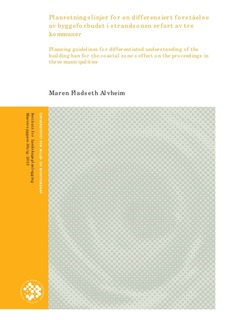| dc.description.abstract | I plan- og bygningsloven er det nå delvis videreført og innstrammet et unntak fra byggeforbudet for å ta hensyn til variasjonene mellom landets kystkommuner. Unntaket innebærer at kommunene må fastsette en ny byggegrense gjennom plan for å fravike forbudet mot bygging i strandsonen. Statlige planretningslinjer for differensiert forvaltning av strandsonen langs sjøen (SPR) er iverksatt med mål om å tydeliggjøre kommunenes adgang til å bygge i strandsonen gjennom plan. Oppgaven søker å avklare om retningslinjene har blitt opplevd som en endring for saksbehandlingen av utbygginger i strandsonen for intervjuede kommuner i studien, både for den enkelte kommune og en forskjellig adgang til å vurdere utbygginger mellom kystkommunene.
For å innhente erfaringer med praktisering av planretningslinjene har tre kommuner blitt intervjuet, en for hver av retningslinjenes soner. Fredrikstad, Tvedestrand og Fitjar kommuner er valgt som informanter for å belyse erfaringer med saksbehandling i henhold til føringene, og intervju av Fylkesmann i Østfold, Fylkesmannen i Aust-Agder og Fylkesmannen i Hordaland supplerer forståelsene av føringene for kommunenes saksbehandling. Erfaringene har blitt innhentet gjennom intervju og kommunenes plandokumenter, og forstått opp mot et studie av blant annet lovforslaget til ny plan- og bygningslov.
Resultatene viser at SPR ikke har medført endringer for saksbehandlingen i Fredrikstad kommune da føringer i rikspolitiske retningslinjer iverksatt allerede i 1993 og flere regionale planer har klargjort utbyggingspraksisen for kommunen. Retningslinjene er ikke oppfattet som å gi en endret adgang til å forvalte strandsonen gjennom plan eller dispensasjon, men kommunerepresentanten mente likevel føringene var til nytte da den virker som å understreke den allerede strenge forståelsen av utbyggingspraksis for kommunen. Fylkesmannen i Østfold supplerte forståelsen til representant for Fredrikstad kommune.
Resultatene fra Tvedestrand kommune viser at kommunen har forsøkt å løse problemet med en ressurskrevende dispensasjonspraksis for å bygge i strandsonen allerede før SPR ble iverksatt. Kommunen hadde derfor ikke ansett SPR som å medføre endringer for saksbehandlingen. Igangsettingen av planarbeidet ble derimot motivert av en konfliktfylt mulighet til å forvalte i strandsonen på bakgrunn av forholdet til tidligere Fylkesmann, og et ønske om å fortsette som en pilotkommune innenfor strandsoneforvaltning.
Representant for kommuneadministrasjonen i Fitjar kommune og Fylkesmannen hadde oppfattet SPR som nye regler for strandsonen, som supplement for åpningen for utbygging i unntaket fra byggeforbudet i § 1-8 tredje ledd. Den faktiske endringen for saksbehandlingen var et resultat av en kartlegging av strandsonen gjennom et regionalt samarbeid, som har gitt mulighet til å fastsette en byggegrense som differensierer muligheten for utbygging i strandsonen. An exception to the rule of prohibition against builing in the coastal zone given by The Planning and Building Act is now partially extended and tightened to take into account the variations between the country's coastal conditions. The exemption means that municipalities must establish a new building limit through planning to waive the ban on construction in the coastal zone. National Policy Guidelines for a Dufferentiated Management of the Shoreline along the Sea (SPR) is implemented with the aim of clarifying the municipalities possibility to build in the coastal zone through planning. This paper seeks to clarify whether the guidelines have been experienced as a change of proceedings of developments in the coastal zone for municipalities interviewed in this study, both for the individual municipality and a different opportunity to consider developments between coastal municipalities.
To obtain data of the management according to the guidelines three minucipalities were interviewed, on for each of the guidelines´three zones. Fredrikstad, Tvedestrand and Fitjar municipalities was selected as informants to illuminate their experiences of case management according to the guidelines, and the County Governor of Østfold, the County Governor of Aust-Agder and the County Governor of Hordaland are interviewed to supplement the understanding of the guidelines importance for municipal proceedings. The data found through the qualitative interviews and municipal planning documents, are discussed against a study of, among other things, the bill for the new Planning and Building Act.
Collected results show that the SPR has not led to any change of the procedure of coastal zone management in Fredrikstad based on current guidelines implemented in 1993 and several regional plans that have already established the development practice for the municipality. The guidelines are not understood as providing a modified right to manage the coastal zone through planning or exemption, but the municipal representative, however, believed the guidelines to be useful as they seem to emphasize the already strict interpretation of the development practice for the municipality. County Governor of Østfold supplemented the understanding of the representative of the municipality of Fredrikstad.
The results from Tvedestrand show that the municipality has tried to solve a problem with resource-intensive exemptions for building in the coastal zone even before the SPR was implemented. The municipality had therefore not considered SPR as causing changes of procedure of building applications. The commencement of the planning process, however, was motivated by a conflict for the opportunity to manage the coastal zone on a local basis, based on the relationship with former county governor and a desire to continue as a pilot municipality within shoreline management.
Representative of the municipal administration in Fitjar municipality and the County Guvernor of Hordaland had perceived SPR as new rules for the coastal zone area as a supplement to the access of development by determining a new building ban in § 1-8 third paragraph. The actual change of procedure is the result of a survey of the coastal zone through regional cooperation which has provided the opportunity to fix a building limit that differentiate the opportunity for development in the coastal zone. | no_NO |
